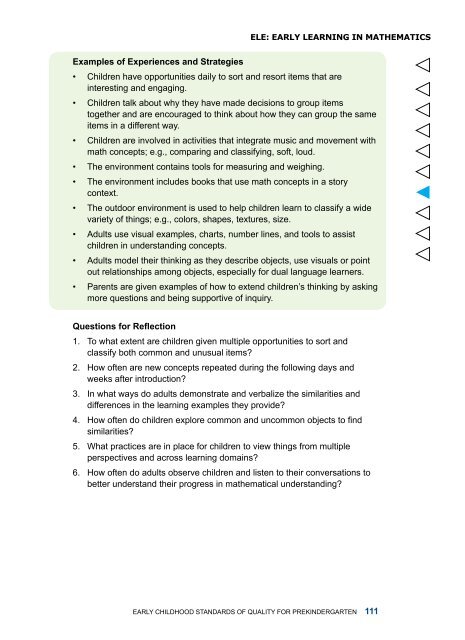Early Childhood Standards of Quality for ... - State of Michigan
Early Childhood Standards of Quality for ... - State of Michigan
Early Childhood Standards of Quality for ... - State of Michigan
You also want an ePaper? Increase the reach of your titles
YUMPU automatically turns print PDFs into web optimized ePapers that Google loves.
ELE: early Learning in maTHEMATICSExamples <strong>of</strong> Experiences and Strategies• Children have opportunities daily to sort and resort items that areinteresting and engaging.• Children talk about why they have made decisions to group itemstogether and are encouraged to think about how they can group the sameitems in a different way.• Children are involved in activities that integrate music and movement withmath concepts; e.g., comparing and classifying, s<strong>of</strong>t, loud.• The environment contains tools <strong>for</strong> measuring and weighing.• The environment includes books that use math concepts in a storycontext.• The outdoor environment is used to help children learn to classify a widevariety <strong>of</strong> things; e.g., colors, shapes, textures, size.• Adults use visual examples, charts, number lines, and tools to assistchildren in understanding concepts.• Adults model their thinking as they describe objects, use visuals or pointout relationships among objects, especially <strong>for</strong> dual language learners.• Parents are given examples <strong>of</strong> how to extend children’s thinking by askingmore questions and being supportive <strong>of</strong> inquiry.Questions <strong>for</strong> Reflection1. To what extent are children given multiple opportunities to sort andclassify both common and unusual items?2. How <strong>of</strong>ten are new concepts repeated during the following days andweeks after introduction?3. In what ways do adults demonstrate and verbalize the similarities anddifferences in the learning examples they provide?4. How <strong>of</strong>ten do children explore common and uncommon objects to findsimilarities?5. What practices are in place <strong>for</strong> children to view things from multipleperspectives and across learning domains?6. How <strong>of</strong>ten do adults observe children and listen to their conversations tobetter understand their progress in mathematical understanding?<strong>Early</strong> <strong>Childhood</strong> <strong>Standards</strong> <strong>of</strong> <strong>Quality</strong> <strong>for</strong> Prekindergarten 111


